Examples Of Processing Free Hosted Galleries
While you can definitely use Image Surfer Pro to build collections of just about any media files on the Internet, there are some pages which Image Surfer Pro has been specifically optimized to process. Free Hosted Galleries are very specific to people surfing the web for images and related videos. They come in essencially two common types:
-
Media content is directly referenced on thumbnail page
A set of thumbnail images on a page where each thumbnail links to a full size version of the image or an associated video which will play on the page or in a small window that opens when the thumbnail is clicked. -
Media content is embedded on subsequent pages referenced by thumbnail page
A set of thumbnail images on a page where each thumbnail links to a new page which shows the full size image or an embedded video along with other page content around the media file.
Video content is often presented through a Frame element on a page and FHGs exist which reference content pages where the content is held in frames. However, automated extraction of frame information is not recommended unless you fully understand the hosting service and how it embedds the frame data. We will not present an example of processing a FHG from a content provider which uses Frames as in most cases this simply doesn't work well. For an example of how to capture video delievered through a frame, check out this walkthrough.
Image Surfer Pro can process both types of FHGs. However, the second type of FHG requires the processing of an ISP Form. Here we use the first type of gallery to provide a foundation for understanding how the second type can also be processed and provide examples of common FHGs which reference images and videos.
For demonstration purposes we will walk through processing a couple of free hosted galleries into the same fusker collection. For discussion purposes we will start with galleries we have identified rather than go through the process of finding suitable pages.
In these examples, the image on the right will link directly to the webpage used as the starting point. The configuation, segment, and final view images will each link to full size images. This allows you to follow along by setting your configuration, going to the website and performing the actions - thus duplicating the results.
Image Free Hosted Galleries
We will start with three examples of processing free hosted galleries which have images as their primary focus.
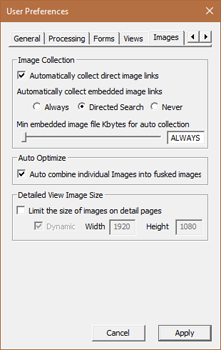
|
Example Description The original site seen on the left shows six thumbnail size images of La Jolla, California, USA hosted by Ace Clipart. It is always safe to click the Configuration Notes Since the FHG we have chosen to process deals only with images, the only configurations which effect how the FHG is processed are those on the Images Tab. In this first example we start with the default settings. {Automatically collect direct image links} enabled will collect the images the thumbnail images link to while leaving {Automatically collect embedded image links} set to Directed Search will keep the border art and thumbnail images out of our collection. Having {Auto combine individual Images into fusked images} enabled, will group images found in the same server path. |
|
Before
|
Resulting File Segment
|
After
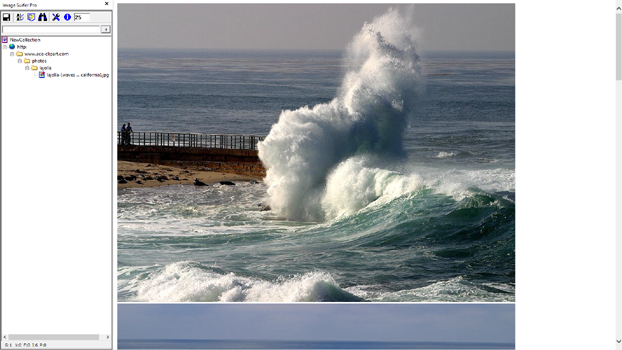
|
| The resulting image file segment is list fusked. The common file extension .jpg is held in the post text and the common leading text "lajolla-" is held in the segment's pre-text after the optimization process. The remainder of each file name appears in the list. We see the visualization of this segment shows all six of the images full size on a single page because the {Limit size of images on detailed pages} configuration is disabled. | ||

|
Description We will process another page from the Ace Clipart website. The first page of sunset images will go well in the fusker collection. There are eight beautiful sunset images referenced by this page. Configuration Notes Now turning off the {Auto combine individual Images into fusked images} configuration we will see how the resulting image file segments remain distinct within the fusker collection. Notice how in this example the images could have been numerically fusked. Becasue the images are found by processing direct image references from a generic webpage Auto Ranging configurations are not applied to them as they are added to the fusker collection. |
|
Before
|
Resulting File Segment
|
After
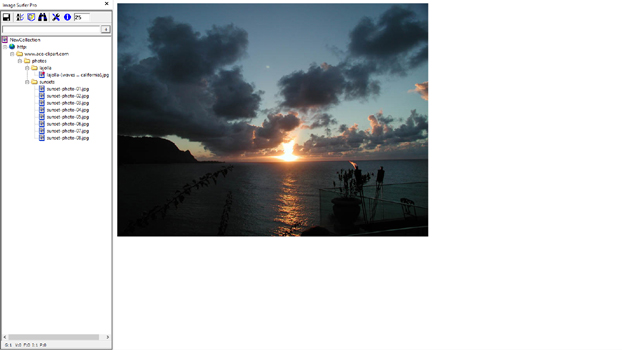
|
| At first glance the result in the IE display window may be surprising - we see only a single image. It is in fact the 8th image in the set. In the Fusker Collection View we see The directory "sunsets" has been added to the tree under www.ace-clipart.com/photos and it contains 8 file segments. Each of the new file segments is structured just as the 8th segment - with the full file name in the PreText. To see all eight images in the same visualization page you would need to display the "Expanded" visualization of the "sunsets" directory. What is displayed after the thumbnail post processing is the last segment added to the fusker collection. | ||
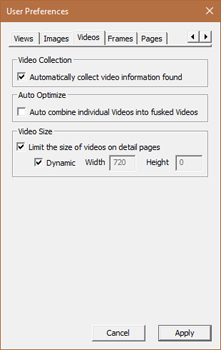
|
Description Image Surfer Pro is capable of referencing media files accross different hosting servers from within the same fusker collection. To demonstrate this and how visible image content on a page can also be collected we will move to some clip art images which could be made into a coloring book from The Learning Page. This thumbnail post has several thumbnails linked to larger images of clip art (15 in total). You will notice the page also has other images embedded around the boarders of the page. The author's picture, some boarder art, some "hand drawn" links to other topics on the page etc. Configuration Notes The previous two examples left the {Automatically collect embedded image links} configuration set to Directed Search. In this example we will change this setting to Always. This setting will cause Image Surfer Pro to add links to every image it finds embedded on the original page to the fusker collection automatically. We have also re-enabled the {Auto combine individual Images into fusked images} to group images found in the same path. |
|
Before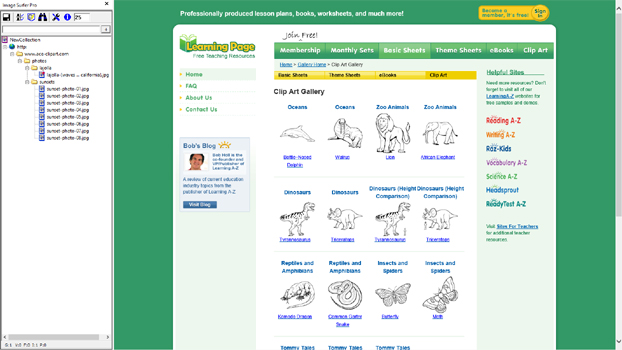
|
Resulting File Segment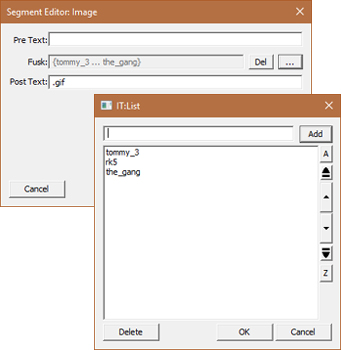
|
After
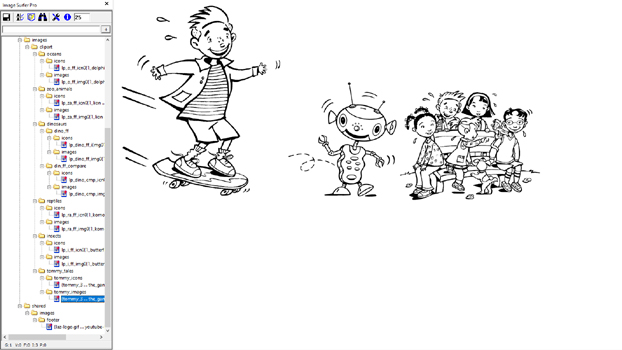
|
|
The Fusker Collection View shows that now both the www.ace-clipart.com and the www.learningpage.com
domains are referenced by the fusker collection. This time the IE display window shows us the last few clip-art
images from the Learning Page thumbnail post. The clip-art on the website is grouped by topic into various
directories. Each of which represents a branch of the fusker collection tree. Each branch has a list fusked file
segment which contains the files in that grouping. The final segment added to the fusker collection was the file
under www.learningpage.com/images/clipart/tommy_tales/tommy_images. The details of the file segment are shown and
we see the name of each of the images in the list editor. For each set of images there is also a directory labled "icons". Under these branches of the tree you will find the thumbnail images embedded on the origianl page which linked to the larger images stored in the "images" directories. Two other branches were also added to the fusker collection: wwww.learningpage.com/shared/images/footer and www.learningpage.com/img where more embedded images from the original page have been referenced. It is worth noting that the structure of the tree formed is based on how the images are actually stored on the server which hosts the learningpage.com domain and that we have no way of moving those files nor changing the basic structure of the fusker collection which accesses those files. |
||
Video Free Hosted Galleries
We started with examples using images because we felt it might be more familiar for the typical Image Surfer Pro user, but the same concepts are employed in the processing of FHGs which focus on videos. Like image FHGs there are any number of possible webpages to use as examples of video FHGs, however, we will focus on just one to show the similarity of processing these pages to the traditional image FHG as well as demonstrate how videos and images may be collected in the same fusker collection.

|
Description ShutterStock is a fairly well known commercial source of stock media files including both images and video. Though the videos directly accessible for free on their site are watermarked with their brand name, they still represent a typical video FHG with some content cool enough to be interesting. In this case we've chosen some slow motion water surface waves/splashing video that goes nicely with our surfing theme. Specifically the FHG page for video clip 3723818. Configuration Notes Because this example focuses on a video FHG we show the Videos Tab of the user preferences. Notice there is only one collection setting for videos: {Automatically collect video information found}. While there are cases where very short embedded videos are used basically as ads on a page, there was not the typical need to separate videos between those embedded on a page and those directly referenced in links on the page. Unlike images, video content is not typically used as pure decoration nor as advertizing. The most common use of video as advertising is done using <iframe> elements which are treated as Frames by Image Surfer Pro rather than videos. Because each video file is typically associated with a meaningful and unique Poster image, we have chosen to keep the default of disabling {Auto combine individual Videos into fusked videos}. It shoud be noted that we also changed {Automatically collect embedded image links} back to the default of Directed Search because we were not interested in collecting the posters and thumbnails from the FHG - just the videos. |
|
Before
|
Resulting File Segment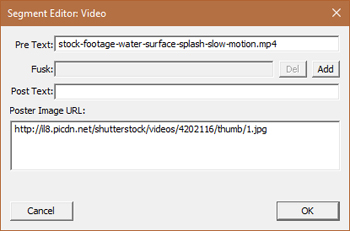
|
After
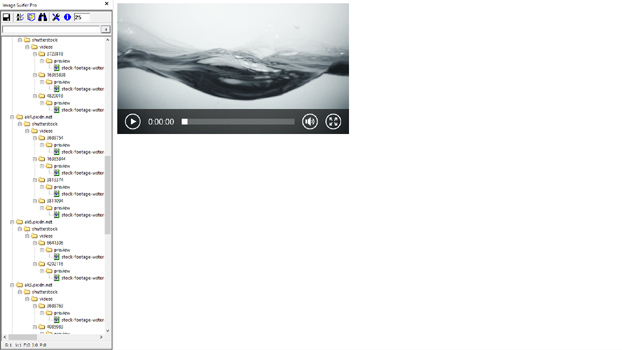
|
|
As expected the browser page was changed to show a single video... but... it wasn't the video we might have expected.
It was not the video that was featured on the original page. Looking closely at the fusker collection we see that in
total 21 videos were added to the fusker collection! Notice on the original FHG page there were 20 different thumbnails
below the featured video on the page - and if you mouse over any of them a small clip of the associated video plays
in a pop up window. Image Surfer Pro was able to find the video file information for each of those videos embedded
in the HTML code of the FHG and thus added them automatically to the fusker collection. If you look closely at how the videos are referenced in the fusker collection tree view you will find the videos are not hosted on the ShutterStock domain. In fact they are hosted on the picdn.net domain. In this case Picdn is providing the "content delivery" services for ShutterStock. This is actually quite common and quite different from how image files are hosted. It is done because the bandwidth requirements for delivering even low resolution streaming video are quite high even by today's standards requiring specialized equipment and internet connectivity that most domain hosting services don't provide. The references to the 21 videos are provided via ten different domains (ak0.picdn.com through ak9.picdn.com). Technically this is a single domain (picdn.com) with 10 different sub domains (ak0 through ak9). This is done in order to direct the 21 streams to a minimum of ten different hosting serves easily - thus spreading out the bandwidth requirements accross those servers which gives a very smooth video experience. However, this can present a problem to the Image Surfer Pro user as now your fusker collection has multiple domain branches for very similar content and organizing the collection may be difficult. In this case (and in most cases) you can manually manipulate the segments to reference them all through the same subdomain and get them to work - but there is no guarantee. Each video is also associated with a number (e.g. 13666370) which is in the directory structure of the reference tree. In some cases videos on content delivery networks are referenced through temporary directory structures which represent hashed references to cached streams. In those cases the fusker collection references are only likely to be valid for a few hours or days at the most. This can make collecting video references pointless - so be sure to understand how the videos you wish to collect are referenced. The last item of note in this walk through is how the poster image is stored for each of our video segments. You will note there is but a single place to store the poster url - so if a video segment is fusked, that single poster image will be used when displaying each video. |
||